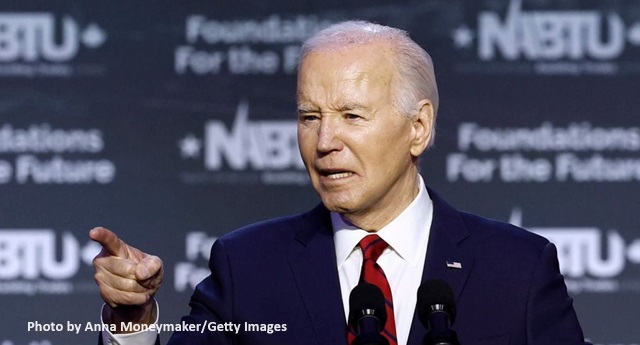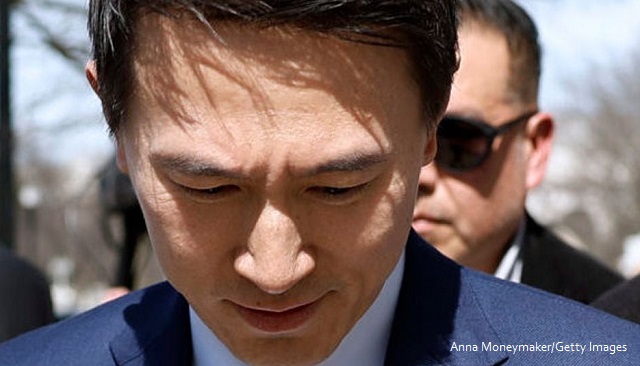If they don’t act, white Americans will soon be subsidizing their own destruction.
This article is adapted from Jeremy Carl’s book, The Unprotected Class: How Anti-White Racism Is Tearing America Apart, which is currently available for pre-order and will be published on April 23.
“I don’t feel responsible for the sins of my father and grandfather. I feel responsible for what the situation is today for sins of my own generation, and I’ll be damned if I feel responsible to pay for what happened 300 years ago.” – Senator Joe Biden, 1975
Major political and social phenomena do not spring up fully armored and ready for battle, like Athena from Zeus’s head. They have powerful motivations that drive them and gestate for years before they can come into being—they also have powerful interests that they serve. I believe that many of the fundamental trends in anti-white politics and rhetoric serve a common ideological purpose. That purpose is to create an intellectual and cultural environment to justify the expropriation of land, property, and other wealth from whites while instituting a permanent regime of anti-white employment and legal discrimination.
While this statement may seem alarmist, in fact, this expropriation is already ongoing. In many cases, it is still on the margins of our popular politics, but like so many other leftist political movements of the twentieth and twenty-first centuries, what was marginal will soon become mainstream.
This is not to suggest that direct expropriation is the conscious strategy of most participants in these movements. Like every good political strategy, anti-whiteness has an exoteric and esoteric meaning—there is an “inner party,” a limited group that understands what the end game is, even if at times they may not even express it to themselves, and a far larger, more diverse, and less sophisticated “outer party” that simply thinks that in attacking “white privilege” they are fighting for “justice.”
Different anti-white political actors are working in their own fields to obtain benefits and status at the expense of whites. These individuals and groups are not engaged in an active conspiracy—there is no “Protocols of the Elders of Anti-Whiteness.” But there is a conscious effort by those in the political system to delegitimize whites and to retell the American story in a way that makes whites the villains to justify expropriating the vast wealth and prosperity largely produced by whites over several centuries on behalf of the new American people.
The social phenomenon of expropriation is, of course, not unique to American whites. The forced expropriations of the Chinese in Indonesia, Jews in Nazi Germany, Tutsis in Rwanda, and Indians in Uganda are just a few of the many recent historical examples where this has occurred. I do not suggest that violence on the scale that we witnessed in these countries is the likely outcome in the United States. (For one thing, even in a white-minority America, white numbers will be much larger, and there will be no one dominant group to oppress them.) On the other hand, for those who have eyes to see it, a great deal of interracial violence of which whites are disproportionately and increasingly victimized has an overt or scarcely hidden undertone of racial revenge.
Sadly, there is a long tradition worldwide of financially and socially successful but politically less powerful groups being expropriated by politically more powerful but financially and socially less successful groups. Multiethnic democracies in which political power is determined by the number of people you can get out to vote, and in which most citizens are members of clearly definable groups, are particularly at risk. And this is not a remote long-term risk but a contemporary and immediate one.
According to the Census Bureau, by 2045 whites will be a minority in America, and that minority will be disproportionately older and less active in society. Already, the median age for white Americans is 43.7, compared to 37.5 for Asian Americans, 34.6 for African Americans, 29.8 for Hispanics, and 20.9 for multiracial Americans.
For now, appeals to expropriation are usually indirect. But over time, these appeals will become more direct and in need of less justification as the political power of white Americans continues to decline.
Reparations
While calls for reparations also sounded absurd when Ta-Nehisi Coates proposed them in 2014 in an article in The Atlantic, a decade later they are increasingly close to reality. It is not a coincidence that the initial push for reparations came not from former slave states (which have large black populations but are generally run by largely white GOP majorities) but from states and localities where whites have reduced political power or where those whites who are present are on the far Left. Evanston, Illinois (home of Northwestern University), implemented one of the first reparations plans, followed by proposals from San Francisco and the state of California.
This expropriation will continue over a matter of decades and will use the government and America’s public institutions, largely built and paid for by several generations of white Americans, as its engine. Universities, built over centuries with hundreds of billions of dollars in donations from white and often conservative donors, have already been captured and turned into engines of racial wealth and status redistribution and anti-white ideology. The value of American university endowments alone is rapidly approaching $1 trillion. Many of these wealth transfers will be disguised as benefits for the poor and disadvantaged, though their racial component will be implicit, and, at times, explicit.
In the modern era, trillions of dollars of “reparations” have been paid in the name of welfare programs, set-asides, quotas, affirmative action, and other programs, much of which has gone to people (African immigrants, Latinos, etc.) who are not even distantly descended from those harmed. Black immigrants and their descendants now represent almost one-fifth (and rapidly rising) of the U.S. black population. Vice President Kamala Harris is one of these, descended from a Jamaican immigrant who was a professor of economics at Stanford. President Obama was descended from an African immigrant who repatriated to Kenya after earning a degree at Harvard. More than half of young adults in Africa want to emigrate, with the United States being the dream destination. Someone clearly forgot to tell all these immigrants—and those who are desperate to cross the border every day—that the United States is a hellhole of systemic racism that discriminates against them.
Nonetheless, the reparations train moves on. California’s, and specifically San Francisco’s, efforts are exemplars of how intellectually vacuous the arguments for reparations are. Keep in mind these are states and cities that never enslaved anyone. And that slavery ended more than 160 years ago, several lifetimes before anyone living today. There are no children of former American slaves living today. Even the last grandchildren of former slaves are passing from the scene. Ironically, before he passed, the last known living child of an American born into slavery spoke of his father’s love and appreciation for his country. “We could never talk negatively about America in front of my father…. He did not have much but he really, really loved America. Isn’t that funny?” It is only funny if you lack the historical perspective that this wise gentleman clearly had.
But, of course, logic and a sense of perspective have nothing to do with reparations. Never mind that African Americans are the wealthiest African-descended people in the entire world by far, and they are infinitely wealthier and better off on average than the Africans whose ancestors were largely responsible for selling their ancestors into slavery. Black Californians should get $350,000 each, said the reparations committee there, while San Francisco has suggested providing up to $5 million and a host of other benefits. The Right loves to mock San Francisco, but pretending that what happens in San Francisco stays in San Francisco is pure wishcasting. Despite dysfunction and emigration, the greater Bay Area has enormous cultural, financial, and technological clout in our current era. For decades now, San Francisco movements that once seemed marginal have been entering and then becoming mainstream. The first legal same-sex marriage was performed under the administration of then-San Francisco Mayor Gavin Newsom in 2004. In 2015, the Supreme Court in Obergefell v. Hodges made it mandatory nationwide. It took just 11 years to go from “crazy thing only people in San Francisco do” to “constitutionally mandated throughout the country.”
The broader philosophical claims of reparations are equally absurd. Collectively, the United States does not owe anyone anything just because they have a certain skin color or because of the experience of their ancestors. The experience of Jews and Asian Americans serve as illustrative examples—both groups have experienced undeniable discrimination in the historical United States, yet both groups are among the most successful in America. Jews today make up approximately one-third of the 400 richest Americans despite being just 2 percent of the population. Asian Americans have the highest income of any ethnic group. Are we going to hand Jewish billionaires and Asian technology executives reparations? History is inherently messy, and the attempt to divide it between perpetrator groups and victim groups is intellectually incoherent and dishonest. It’s also politically explosive. What Thomas Sowell calls the “quest for cosmic justice” invariably, as he notes, causes greater injustice.
Reparations Beyond Black and White
Calls for black reparations for slavery are just the edge of the anti-white expropriation racket. Just as “medical” marijuana opened the door to mass decriminalization and legalization, black reparations will open the door to massive multi-trillion-dollar payments to any group that can seize the holy grail of victimhood—payments that will, implicitly or explicitly, come from the white “perpetrator” class. As my Claremont Institute colleague and longtime Californian Steve Hayward said in a recent interview, “This is an invitation to open ethnic conflict in the country.” But attempting to make sense of reparations in the context of logic and facts misses the point. The current quest for reparations is a pure racial shakedown.
We aren’t going to win this fight by nibbling around the edges, by compromising, or by saying that groups deserve reparations for this but not that. We must pull up root and branch the entire concept of mass racial reparations. Otherwise what will follow will be an attempt at racial extortion on an almost unimaginable scale, one far more likely to lead to inter-ethnic violence and a collapse of American society.
America needs to decide: Does it want mass interracial score-settling or does it want something resembling a functioning multiethnic democracy? How we deal with demands for reparations will determine what future lies before us.
Land Acknowledgments and Land Expropriation
If white Americans are gullible enough, or politically weak enough, to fall for this, they can be sure every discernible minority or “marginalized” group from left-handed lesbians to transgender Native Americans will be next in line. Asian Americans (the Chinese Exclusion Act, limitations on citizenship) will step up. Hispanics (Operation Wetback, the Mexican-American War) will have even more claims.
The entire white population will become a lower caste with “liabilities” in the trillions. These are more likely to be taken from communal American assets than individual white people per se, because when acting through large government programs and policies, it is easier to hide what is really being done. But functionally the net result will be similar, with some trade-off in expropriation efficiency being an acceptable compromise to at least provide a fig leaf of respectability for what is going on. Some of this can be done through the tax code. Another likely method will be the “return” of “stolen” lands, whether to “indigenous communities” or to Mexican Americans for whom “the border crossed them.”
The ideological predispositions for this can be seen in the birth and growth of so-called “land acknowledgments”—a practice that began among left-wing Canadians and has exploded in popularity within American universities and governments. It is customary in many spaces now to use “a carefully crafted public statement to express a commitment to the past history, current reality and future relationship between the institution, Indigenous Peoples/Nations and the land.”
Such “land acknowledgments” quickly devolve into laughable intellectual incoherence. Multiple lands were claimed by multiple tribes in warfare over countless generations. Many tribes were exterminated entirely by groups claiming their land. But “we’d like to honor the Chippewa, who drove the Sioux out of their ancestral lands into new lands where they could massacre the Pawnee, Omaha, and Kiowa” just doesn’t sound as touchy-feely as anti-white leftists would like it to be.
Land acknowledgment is an intellectual precursor to expropriation and needs to be treated as such. Those angrily demanding land acknowledgments are sitting in their natural gas-heated homes, watching television and driving internal combustion cars over paved roads, all largely developed by white Americans or their European “cousins.” Such demands for redress merely need to serve the grubby ideological or financial interests of those making them.
Others demand reparations for land allegedly stolen from ancestors, often based on highly contestable claims. A 2020 article describes Mexican Americans as also seeking their “stolen” lands. This claim is based on their opinion that land agreements were not honored (largely because the terms of those agreements were not agreed to by the U.S. Senate, which ratifies treaties). “We come from Spanish communities that came over, [and from] Native American communities as well,” one interviewee said. “So we really are sort of mestizo. We’re mixed…We’re a land-based people. Half of our soul was here before Columbus ever hit the sand.”
She seemed less eager to acknowledge that the Spanish land grants her family received were merely expropriating the natives. “Losing their land” in many cases simply means the families sold the land—not because they were legally expropriated. They, like anyone who sells land, simply needed or wanted the money for other things. Yet legislation is being pushed in Congress to give a “federal definition of traditional uses on federal lands for land grant communities…. Access to fuelwood, for example, to heat your home. Access to pasture to graze livestock [a huge economic value]. And it would also require that the federal agencies work with land grant communities and consult with them.” In other words, this is a shakedown for land they sold and don’t own. Expect to see much more of this in the future.
The final destination is a world in which whites have been stripped of political power and resources, which are then redistributed to non-whites using both “legal” and “democratic” processes. Again, this is already underway, but its speed and scale will dramatically increase as white political power diminishes. That the expropriators may not succeed is only true to the extent that whites can politically organize themselves and sympathetic non-white allies to oppose the state-sanctioned theft of their wealth and assets. White Americans already pay billions each year to subsidize our cross-border invasion and cultural erasure. If we don’t fight harder, we will soon be subsidizing our own expropriation.
*****
This article was published by The American Mind and is reproduced with permission.
Image Credit: YouTube Screenshot











